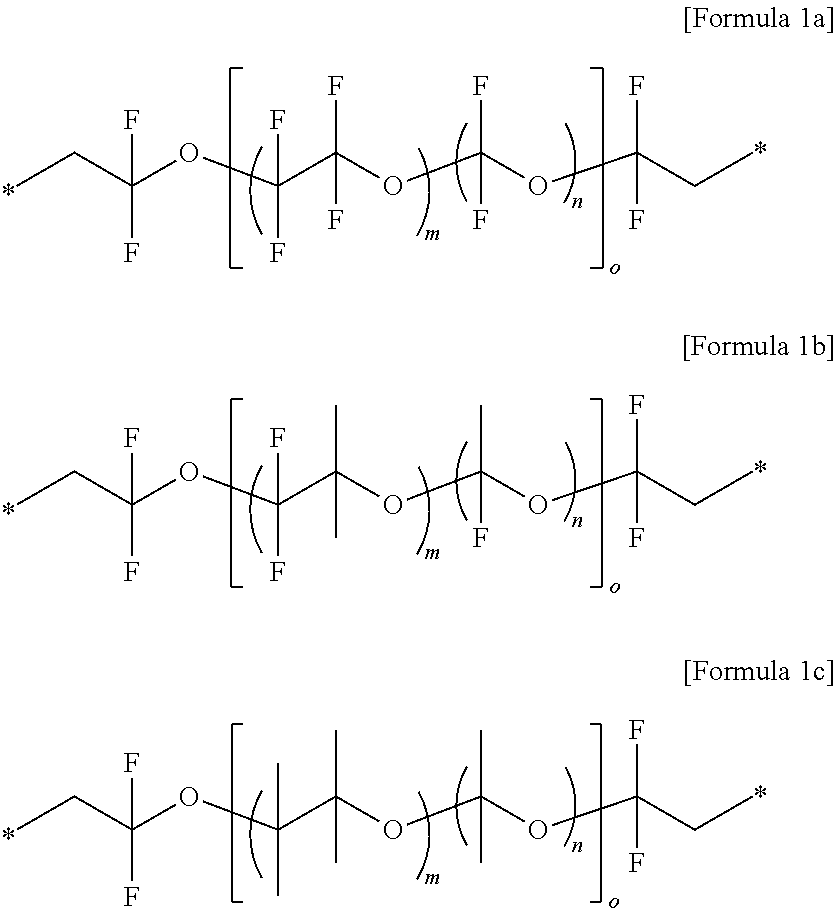Gel polymer electrolyte and lithium secondary battery including the same
a polymer electrolyte and secondary battery technology, applied in the direction of cell components, final product manufacturing, sustainable manufacturing/processing, etc., can solve the problems of low lithium ion conductivity, disadvantages of polymer electrolyte, limitations in improving the performance and safety of the battery, etc., to reduce the resistance of the battery, increase the degree of freedom of lithium (li) ions, and high lithium ion conductivity
- Summary
- Abstract
- Description
- Claims
- Application Information
AI Technical Summary
Benefits of technology
Problems solved by technology
Method used
Image
Examples
example 1
[0297](Preparation of Composition for Gel Polymer Electrolyte)
[0298]After a mixed solvent was prepared by mixing ethylene carbonate (EC) and ethylmethyl carbonate (EMC) in a volume ratio of 3:7 and adding 1.0 M LiPF6 thereto, 5 g of the oligomer of Formula 3a (weight-average molecular weight of 7,800, molar ratio of unit B:unit A was 1:2), 0.5 g of 2,2′-azobis(iso-butyronitrile) (AIBN), as a polymerization initiator, and 0.5 wt % of vinylene carbonate (VC) were added to 94 g of the mixed solvent prepared to prepare a composition for a gel polymer electrolyte.
[0299](Secondary Battery Preparation)
[0300]A positive electrode mixture slurry was prepared by adding 94 wt % of LiNi1 / 3CO1 / 3Mn1 / 3O2 (NCM) as a positive electrode active material, 3 wt % of carbon black as a conductive agent, and 3 wt % of polyvinylidene fluoride (PVDF) as a binder to N-methyl-2-pyrrolidone (NMP) as a solvent. An about 20 μm thick aluminum (Al) thin film, as a positive electrode collector, was coated with the po...
example 2
[0303]A secondary battery including a gel polymer electrolyte was prepared in the same manner as in Example 1 except that the oligomer of Formula 3b (weight-average molecular weight of 7,800, molar ratio of unit B:unit A was 1:4) was used instead of the oligomer of Formula 3a during the preparation of the composition for a gel polymer electrolyte in Example 1.
example 3
[0304]A secondary battery including a gel polymer electrolyte was prepared in the same manner as in Example 1 except that 12 g of the oligomer of Formula 3c (weight-average molecular weight of 7,800, molar ratio of unit B:unit A was 1:4) was mixed with 87 g of the mixed solvent during the preparation of the composition for a gel polymer electrolyte in Example 1.
PUM
| Property | Measurement | Unit |
|---|---|---|
| thickness | aaaaa | aaaaa |
| particle diameter | aaaaa | aaaaa |
| thickness | aaaaa | aaaaa |
Abstract
Description
Claims
Application Information
 Login to View More
Login to View More - R&D
- Intellectual Property
- Life Sciences
- Materials
- Tech Scout
- Unparalleled Data Quality
- Higher Quality Content
- 60% Fewer Hallucinations
Browse by: Latest US Patents, China's latest patents, Technical Efficacy Thesaurus, Application Domain, Technology Topic, Popular Technical Reports.
© 2025 PatSnap. All rights reserved.Legal|Privacy policy|Modern Slavery Act Transparency Statement|Sitemap|About US| Contact US: help@patsnap.com



